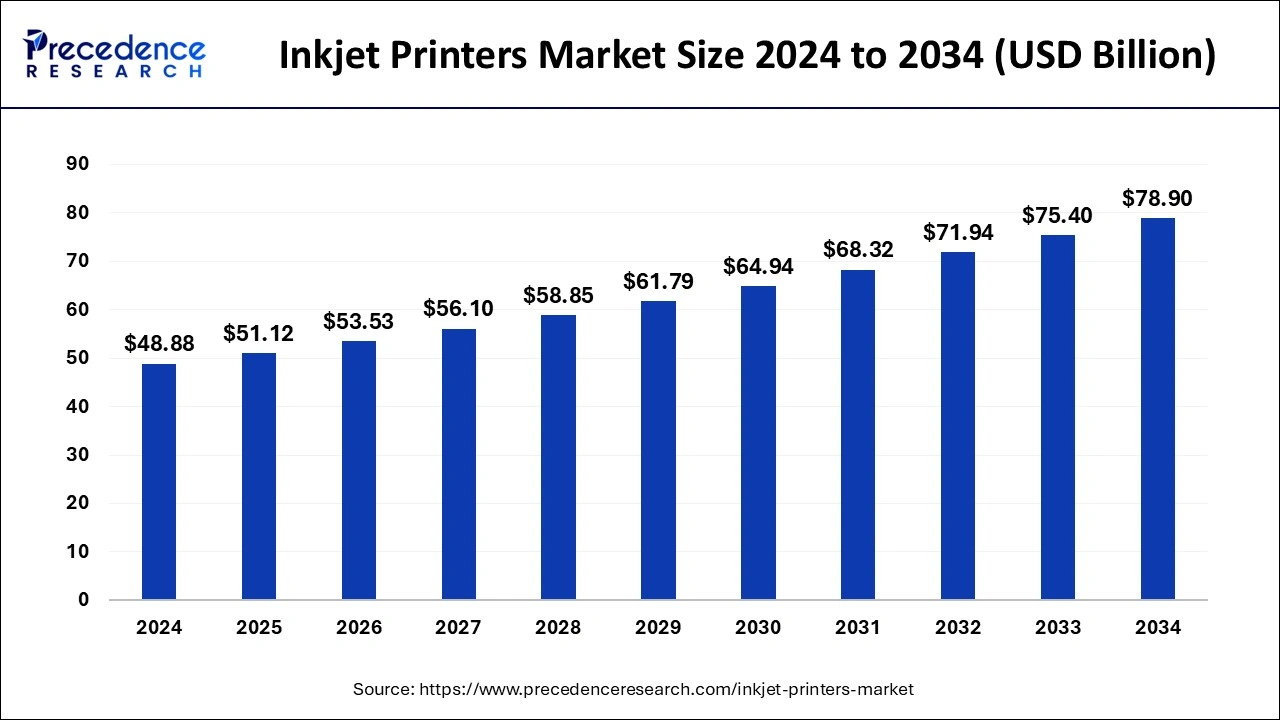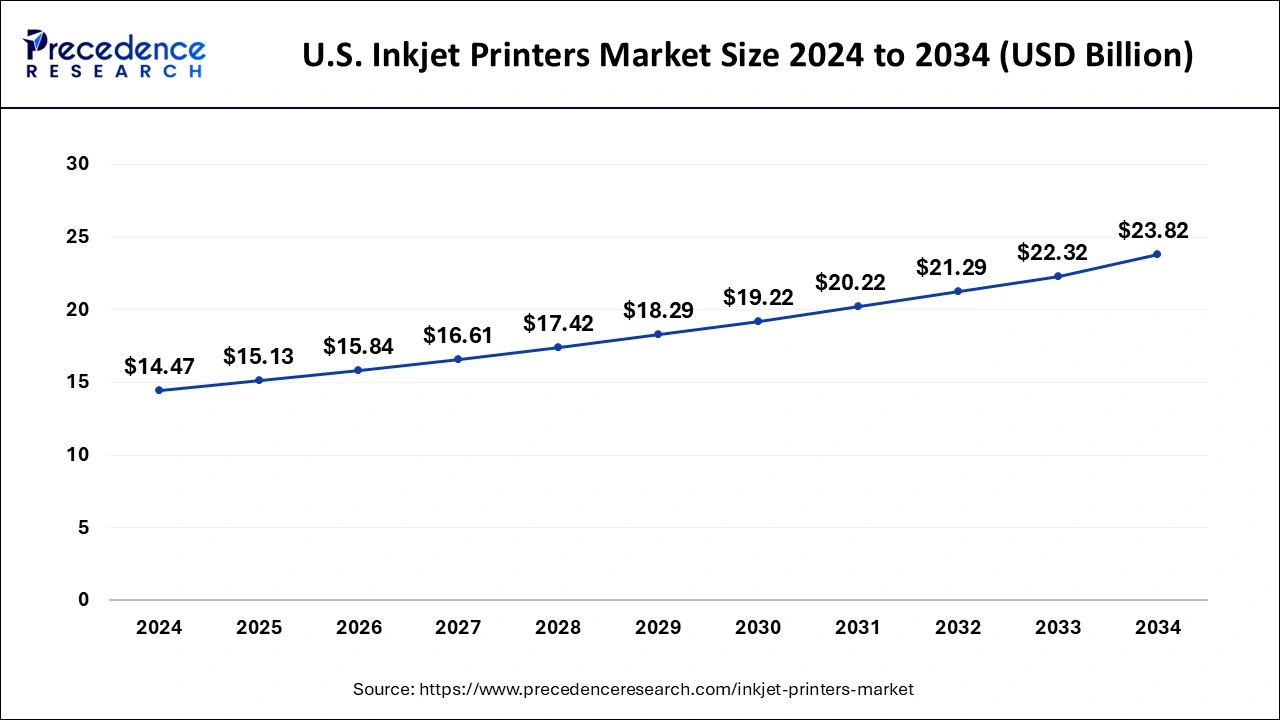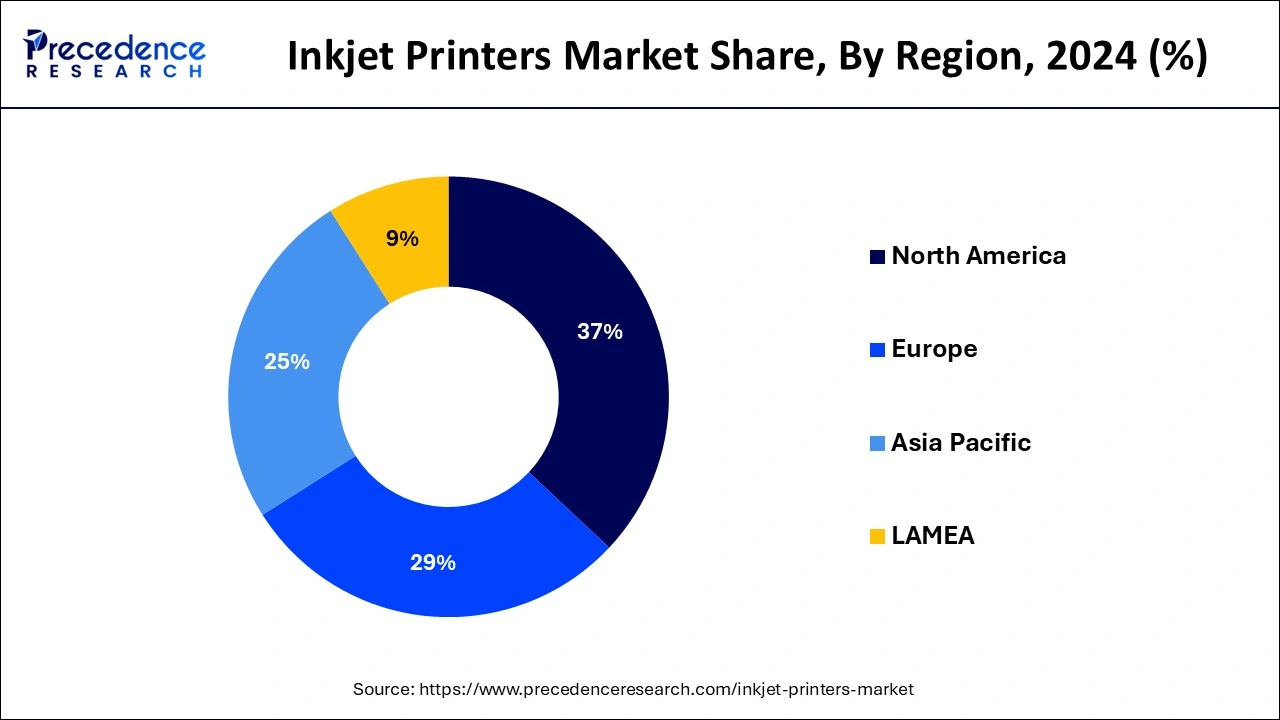The global inkjet printers market size is calculated at USD 51.12 billion in 2025 and is forecasted to reach around USD 78.90 billion by 2034, accelerating at a CAGR of 4.90% from 2025 to 2034. The North America inkjet printers market size surpassed USD 18.09 billion in 2024 and is expanding at a CAGR of 5.04% during the forecast period. The market sizing and forecasts are revenue-based (USD Million/Billion), with 2024 as the base year.
The global inkjet printers market size was accounted for USD 48.88 billion in 2024 and is anticipated to reach around USD 78.90 billion by 2034, growing at a CAGR of 4.90% from 2025 to 2034. The inkjet printers market is growing because of an increased need for enhanced printing quality for packaging, and advertising purposes, and various businesses with advancements in technology for distinct and varied printing facilities.

The integration of Artificial intelligence (AI) and automation is transforming inkjet multifunction printers by increasing utility and efficiency. Smart print technologies controlled by AI can allow print businesses to minimize material waste, artificial intelligence uses machine learning algorithms and advanced technologies to efficiently automate print operations. The specific benefits of artificial intelligence are enabling the better management of prints, better prognosis of equipment malfunction, or the automatic reorder of ink, which in turn lead to improved productivity and less time out. AI employs several strategies in learning machines, and innovative technologies in order to enhance print solutions automation. These aspects include the specification of the print jobs, the capability of the printer, available resource, priority and time deadlines, with the help of which AI optimally plans the production of the printer.
The U.S. inkjet printers market size was evaluated at USD 14,47 billion in 2024 and is predicted to be worth around USD 23.82 billion by 2034, rising at a CAGR of 5.11% from 2025 to 2034.

North America is expected to contribute the largest revenue share of more than 37% in 2024 owing to the presence of major market players in the region such as Xerox Corporation, Inkjet Inc., Epson Pvt Ltd., Videojet Technologies Inc. and Keyence Corporation. Also, the growth of the pharmaceutical industry in this region is a driving factor for the growth of the inkjet printer market.

Asia Pacific is witness to grow significantly over the forecast period owing to the availability of cheap labour and low manufacturing cost in this region. Also, the easy availability of raw materials for the production of inkjet printers is yet another factor that boost the growth of the inkjet printer market in this region. For instance, On 22nd January 2021, Epson, a world leader in digital imaging and printing solutions announced its launch of first ever industrial level Direct-to-Garment printer, Epson SureColor SCF303. It offers high productivity and is cost effective. The printer targets drop-shipment jobbers, e-commerce customers, garment screen printers and new start-ups engaged in personalized T-shirt printing business.
| Report Highlights | Details |
| Market Size In 2024 | USD 48.88 Billion |
| Market Size In 2025 | USD 51.12 Billion |
| Market Size In 2034 | USD 78.90 Billion |
| Growth Rate From 2025 to 2034 | CAGR of 4.90% |
| Largest Market | North America |
| Base Year | 2024 |
| Forecast Period | 2025 to 2034 |
| Segments Covered | Type, Technology, End User, and Region |
| Regions Covered | North America, Europe, Asia-Pacific, Latin America, and Middle East & Africa |
The Inkjet Printers Market is divided into Multifunctional Printers, Desktop, Large Format, Inkjet Press, Industrial, Textile and Others. The multifunctional printer segment is expected to witness the highest growth accounting for more than 25% of revenues share in 2024. It is also considered to grow significantly during the forecast period. The lucrative features that increase the demand for the multifunctional printers includes high speed, affordability and multifunctional capabilities such as copy, print, scan, and fax into one machine. Additionally, the surge in demand for the multifunctional printers in the healthcare sector is one of the primary factors that fuels the market growth.
Furthermore, the wide scale utility of multifunctional printers across corporate offices and academic institutions, such as colleges and schools will contribute positively towards the growth of the market. The multifunctional printers are also used in diverse operations such as copy, print, paper handling, scan, and fax and this attribute has fostered the market growth. With the enhancement of technology, the inkjet printers can now be connected with Wi-Fi, LCD screens, Bluetooth and USB. All these attributes are expected to drive the growth of the inkjet printer market.
The Inkjet Printers Market is divided into Continuous Inkjet, Drop on Demand, UV Inkjet and Others. The continuous inkjet printer in this segment is forecasted to contribute the largest revenues share of more than 40% in 2020 and is estimated to grow remarkably over the forecast period. This type of printers offers features such as minimum leak of Volatile Organic Compounds (VOCs), lower maintenance cost and the option to fill different types of inks. All these features offered will act as a driving factor for the market growth. The users mostly prefer these technology continuous inkjet printers as it offers sealed cartridge-based systems for ink delivery that simplifies replacement while minimizing the possibility of the spill. All these attributes are anticipated to drive the growth of the continuous inkjet printers.
During the forecast period, the Drop on Demand (DOD) inkjet technology printers are estimated to grow at the fastest rate owing to the beneficial features it provides such as reduced downtime, flexibility and functionality. In this inkjet printer liquid is ejected from the print head only when a drop is necessary. It is primarily used in industrial application such as printing on timber, plasterboard, plastics, hardware, metals, packaging, and concrete products.
The Inkjet Printers Market is divided into Consumer, Education, Industrial, Textile, Pharmaceutical and Others. The industrial segment is expected to witness a significant revenue share during the forecast period amounting for more than 25% of the global share. It is also anticipated to grow at a CAGR of 7.1% during the forecast period owing to the higher operating speed provided by the industrial inkjet printers. This high operation speed provided by the industrial inkjet printers enables the coding and marking of products with high velocity that facilitates the manufacturers to design products of different sizes and shapes. Also, these printers can be used in printing cylindrical surface that increases its utility in the cylindrical products industry which includes bottles, small drums and pipes. The industrial segment consists of publishing, packaging and photography.
The packaging segment dominates the inkjet printer industry by contributing the largest revenue share of more than 55% in 2022 and is estimated to lead the market in the upcoming years. The packaging industry makes use of inkjet printers to high-quality packages, labels and also offers various benefits such as low printing cost, fast turnaround time and flexibility.
The global Inkjet Printers Market is characterized by the presence of various small and big players. The major market players are Videojet Technologies, Inc., Xerox Corporation, Pannier Corporation, Canon Singapore Pvt. Ltd., HP Development Company, L.P., Brother Industries, Ltd., KEYENCE CORPORATION, Konica Minolta, Inc. and Seiko Epson Corporation. As the market is competitive in nature, the players are indulged in rapid adoption of advanced technologies to improve the performance of the printers and in raising their competitive share by means of strategic initiatives like mergers, new product and acquisitions.
By Type
By Technology
By End-user
By Geography
For inquiries regarding discounts, bulk purchases, or customization requests, please contact us at sales@precedenceresearch.com
No cookie-cutter, only authentic analysis – take the 1st step to become a Precedence Research client